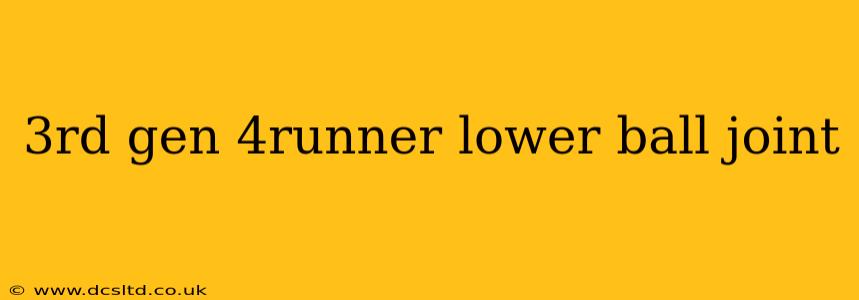The Toyota 4Runner, especially the 3rd generation (1996-2002), is known for its rugged reliability and off-road capabilities. However, like any vehicle, regular maintenance is crucial, and the lower ball joints are a key component that often requires attention over time. This comprehensive guide will cover everything you need to know about 3rd gen 4Runner lower ball joints, from understanding their function to replacing them.
What is a Lower Ball Joint?
A lower ball joint is a critical part of your 4Runner's suspension system. It's a spherical bearing that connects the lower control arm to the steering knuckle. This joint allows the wheel to move up and down while also pivoting left and right, enabling steering and suspension articulation. Worn or damaged lower ball joints can lead to a range of problems, impacting your vehicle's handling, safety, and overall performance.
Signs of a Worn Lower Ball Joint
Several symptoms can indicate that your 3rd gen 4Runner's lower ball joints are wearing out. These include:
- Clunking or popping noises: Especially when turning or going over bumps. This is a classic sign of worn ball joints.
- Wobbly steering: A loose or worn ball joint can result in imprecise steering and a feeling of looseness in the front end.
- Uneven tire wear: If one tire wears more quickly than the others, it could be an indicator of suspension issues, including bad ball joints.
- Excessive play in the wheel: If you can grab the wheel at the top and bottom and feel significant movement, this could point to a problem with the ball joint.
- Vibrations in the steering wheel: A worn ball joint can introduce vibrations felt through the steering wheel.
How Often Should I Replace My Lower Ball Joints?
There's no set mileage for replacing lower ball joints. Their lifespan depends on driving conditions, driving style (aggressive off-roading accelerates wear), and overall vehicle maintenance. However, a good rule of thumb is to inspect them every 50,000-75,000 miles or as part of your regular vehicle inspection. Regular lubrication can extend their life. Professional inspection is recommended if you suspect any issues.
How Much Does it Cost to Replace Lower Ball Joints?
The cost of replacing lower ball joints varies depending on several factors:
- Labor costs: Labor charges will differ based on location and mechanic.
- Parts costs: You can purchase OEM (Original Equipment Manufacturer) parts, or aftermarket options. OEM parts are typically more expensive but often offer a longer lifespan and better quality. Aftermarket parts provide a cost-effective alternative.
- Vehicle condition: Additional repairs might be necessary if other parts are damaged.
Expect to pay a few hundred dollars for parts and labor combined for a professional repair. Doing it yourself can significantly reduce the cost, but it requires mechanical aptitude and the right tools.
Can I Replace Lower Ball Joints Myself?
Yes, replacing lower ball joints is possible for those with mechanical experience and the necessary tools. However, this is a complex repair involving specialized tools and procedures. Improper installation can lead to safety hazards. If you're not confident in your abilities, it's strongly recommended to have a professional mechanic perform the replacement.
What Tools Do I Need to Replace Lower Ball Joints?
Replacing lower ball joints requires a substantial set of tools, including:
- Jack and jack stands: For safely lifting and supporting the vehicle.
- Wheel chocks: For added safety.
- Socket set and wrenches: Various sizes are needed for removing and installing components.
- Ball joint separator: A critical tool for removing the ball joint from the control arm.
- Torque wrench: Essential for tightening bolts to the correct specifications.
- Press (optional): May be needed for pressing in the new ball joints, depending on the replacement parts.
Are there any specific considerations for 3rd gen 4Runners?
The 3rd gen 4Runner's lower ball joint replacement is generally considered a challenging DIY repair due to the design and limited space for working underneath the vehicle. The process often requires specialized tools and careful attention to detail. Consult a reputable repair manual specific to your year and model 4Runner.
This guide provides a general overview of 3rd gen 4Runner lower ball joints. Remember, always consult your vehicle's owner's manual and seek professional help if you are unsure about performing any maintenance or repair yourself. Prioritizing safety and correct installation is paramount.
